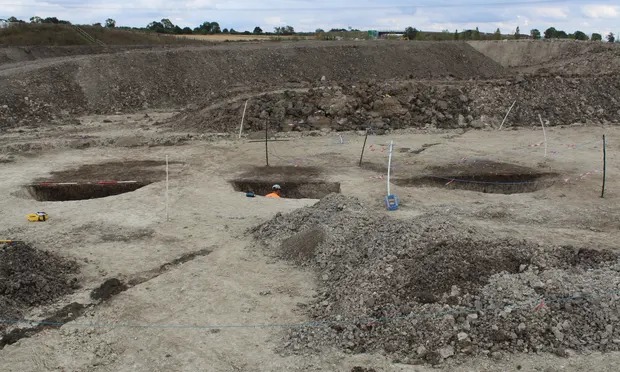
Archaeologists have made a remarkable discovery of Mesolithic Pits in Bedfordshire, England. They stumbled upon a site with massive holes, believed to number around 25. The experts are amazed!
These ancient pits were found in a location called Linmere, and they date back to the Mesolithic period. That’s a time in history that goes back 12,000 to 6,000 years ago. Sadly, we don’t have many clues about our ancestors who lived as hunter-gatherers during that era.
However, these Mesolithic pits could shed new light on the far distant period in history. They are arranged in patterns and concentrated around old paths where streams once flowed. This may suggest that they held great spiritual importance to the people who created them.
Why is the site special?
The site is extraordinary because it has more of these pits in one place than anywhere else in England and Wales, even more than the famous Stonehenge. Through radiocarbon dating, experts have determined that these pits were made between 7,700 and 8,500 years ago.
The researchers from the Museum of London Archaeology (Mola) who are leading this investigation are very excited. They say, “This date makes the site incredibly significant because there are very few Mesolithic sites in the UK that are this substantial. Evidence from this period is often slim, only consisting of flint tools and occasional butchered animal remains.”
Large and enigmatic pits
The uncovering of this ancient site has stirred great excitement, as described by Prof. Joshua Pollard, a renowned specialist from Southampton University who has been involved in significant undertakings related to the landscapes of Stonehenge and Avebury.
He said, “While we know of other large and enigmatic pits dug by hunter-gatherers from elsewhere in Britain, including at Stonehenge, the Linmere pits are striking because of their number and the wide area they cover.”
The creation of these immense pits is truly an extraordinary accomplishment. The circular pits, measuring up to 5 meters (16.4 feet) in width and 1.85 meters in depth, possess steep sides that occasionally widen at the base.
Exploration of the area and its results
The site of Mesolithic Pits has been subject to exploration as part of two distinct development projects. Albion Archaeology conducted research in one area, while Mola excavated another. Within some pits, the archaeologists made a significant discovery—animal bones—a crucial source of valuable evidence.
Among these were the skeletal remains of aurochs, a type of wild cattle, indicating that people had partaken in feasts featuring these creatures.
Yvonne Wolframm-Murray, a project officer at Mola, expressed her surprise at the unexpected nature of the discovery.
She stated, “We knew there was archaeology, but didn’t initially know we had Mesolithic pits until the radiocarbon dates came back. It’s very exciting … There’s only a handful of known other sites with pits that are comparable, certainly quantity-wise.”
The archaeologists have pondered whether these pits were used for hunting or storing food. However, they consider such theories unlikely due to the shape and size of the pits.
Of particular interest to them is the arrangement of the pits in various straight lines, some stretching up to 500 meters in length.
While other Mesolithic pits aligned similarly have been found elsewhere in Britain, the alignments at Linmere appear to be connected to previous stream channels.
Significance of the construction of pits
According to the archaeologists, the immense effort invested in constructing these pits, their alignment patterns, and their proximity to water sources suggest a potential spiritual or special significance.
It is plausible that they served as markers for important locations within the landscape. Furthermore, the experts are investigating whether these pits were intentionally aligned with significant celestial events, such as the solstice.
An incredible find for #MesolithicMonday – 25 huge pits found in Linmere, Bedfordshire 😍
This one site has the most of this type of pit found anywhere in England and Wales, PLUS it looks like they may be laid out in long lines! pic.twitter.com/B3PYe9o0zT
— MOLA (@MOLArchaeology) July 3, 2023
Yvonne Wolframm-Murray remarked, “During the Mesolithic period, ice sheets covering much of the country retreated and sea levels rose, cutting off Britain from mainland Europe. This was a crucial time of transformation in the UK’s past, and studying a site where people made such a mark on the landscape could have far-reaching impacts on how archaeologists understand these ancient communities.”
Analysis and examination of artifacts
The archaeologists are conducting thorough analyses and examinations of the unearthed artifacts and evidence in the laboratory.
They aim to determine whether the pits were all excavated and utilized simultaneously, and gain insights into the surrounding vegetation. Notably, evidence of oak, hazel, and pine have already been identified, and the researchers are examining surviving pollen from the Mesolithic period.
Wolframm-Murray emphasized, “This work will reveal the environment these people lived in, and hopefully answer the question ‘what were these pits for?’”
See all the latest news from Greece and the world at Greekreporter.com. Contact our newsroom to report an update or send your story, photos and videos. Follow GR on Google News and subscribe here to our daily email!



